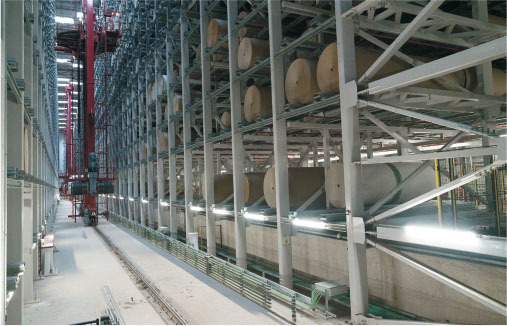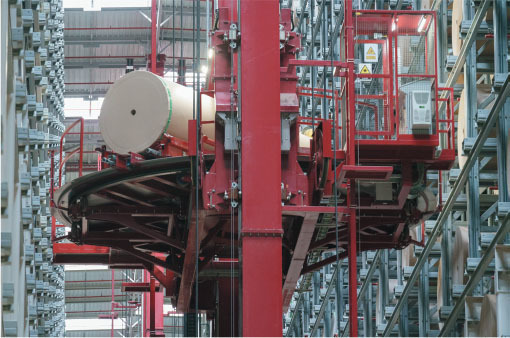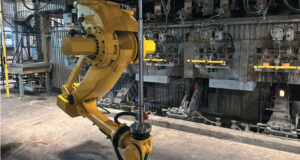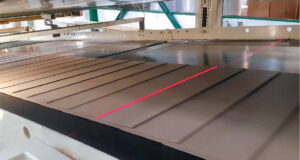
It was an impressive but slightly eerie sight: a large stacker crane in a tall warehouse operating autonomously in low lighting as it went about its task of curating the stock of thousands of reels of paper. In a shock move, the giant robotic stacker suddenly comes speedily toward our group and stops just in time, one arm shooting up as it makes another decision to collect reels from way above us. It then drops down and speedily goes back, transporting the reels to the other end of the warehouse and to the truck collection area.
There was not a pallet in sight, nor any reels of paper stacked on top of each other. This is the future of mill logistics.
We were looking at the latest in digitalized warehouse technology for the paper industry, delivered by Finnish company Pesmel at Saica’s El Burgo mill—and it’s helping make a huge difference in keeping customers satisfied.
David Maeso, supply chain director at Saica, says, “We have been facing challenging market conditions, and therefore we had to look very closely at customer satisfaction and find ways to rise above our competition. The fact is, we needed to be on another level, delivering our products faster, with more flexibility, and ultimately cutting down lead times across the whole operation.
“The warehouse is an important tool we have invested in at our El Burgo mill and is a big part of the major transformation we have made in improving our supply chain model. We have also heavily invested in digital systems to find out exactly what our customers’ needs are, anticipating their demands and even in some cases managing their inventories for them.”
The overall goal of the transformation in logistics was to bring delivery times down from an average of 10-12 days to 2.5 days. “There was no way that we could have attempted this goal without the investment in an automated warehouse,” adds Maeso.
A PROACTIVE SUPPLY CHAIN
After a lot of research into automated warehousing, Saica chose Pesmel to supply the solution due to its proven experience in moving rolls for the paper industry and being able to build a bespoke warehouse that could cope with the demands of the mill’s customers.
Juan Antonio Meler Conesa, Saica’s paper industrial projects director, says, “After learning about Pesmel’s warehousing solutions in a magazine article, we contacted the company in Finland and began a very deep collaboration. It was clear Pesmel had the knowledge and technology we needed and, after 18 months of planning and designing, both parties came up with a solution that would work.”
Kaj Fahllund, vice president, Pesmel, says, “Working together closely, we came up with a solution that fulfilled Saica’s target to convert its supply chain from passive to proactive. Proactive is ‘moving and doing’—as opposed to passive, which is ‘sitting and waiting’. Saica needed an efficient, agile way to store and move its rolls, and we created what I believe is the largest and most effective warehousing solution in the global paper industry.
“The original manual warehouse was 28,500 m3 and stored 35,000 metric tons of paper reels. The new automated warehouse has a footprint of only 10,700 m3 and has a storage capacity of 65,000 metric tons. Saica can store six metric tons of paper rolls per square meter with the Pesmel solution as opposed to just one metric ton per square meter in the old manual warehouse. This is due to the 35-meter height of the new warehouse, as well as the increased density of storage due to the automation solution.”
MAXIMUM PRODUCTION, MINIMUM DISRUPTION
The warehouse development at the mill represents an investment of EUR65 million (US$70 million) and is part of Saica Group’s strategy to provide its mills with the very latest innovative technologies to guarantee the highest quality of products and services.
Due to the complexity of this particular installation, the project was carried out in two phases, with Phase I coming into operation in October 2019, and Phase II starting up in September last year. For the first phase, a capacity of 31,000 metric tons was built to store paper rolls from the mill’s PM8 and PM9. The second phase has a capacity of 34,000 metric tons to store reels for PM10 and the mill’s off-machine coating line.
“We carried out this project in two phases simply because we needed to maintain production throughout and keep disruption down to a minimum around the mill,” says Meler. “This was a challenge, but we achieved our aim, and after a short break we began work on Phase II.
“Looking back, this was a real challenge; the construction took place while we were in full production with many truck movements continuing to deliver and pick up from the mill. We also had the added challenge of COVID-19, which hit during the installation.”
In total, crews used around 8,000 tons of steel during the construction of Phase I and II and fastened some 2.2 million bolts to fix the steel racks together in modular construction before erection on the site. There are some 70 kilometers of channels to store the paper reels.
“This may be a fully automated warehouse, but the need for skilled workers was explicit during this project,” adds Meler.
INTEGRATED AND SAFE
On Paper360°’s visit, the Pesmel automated warehouse was in its optimization stage but fully operational, storing and moving up to 4,000 different products the El Burgo mill provides for its customers all over the globe. The mill makes 75 different basis weights and numerous different sizes to accommodate customers’ needs—with more products being developed to make sure every need is met.
“This warehouse is achieving exactly what we wanted it to achieve,” says Maeso. “We are transforming from a Make to Order (MTO) model, where manufacturing is driven by demand, into a Make to Stock (MTS) model, offering an integrated, proactive supply chain that is totally geared toward meeting the needs of the customer.
“This new model is based on establishing stock levels according to consumption forecasts, which allows us to reduce delivery time. We have defined service level indicators measured through information management and monitoring systems, which allow us to calculate shipping, stock, and production needs.”
David Maeso, supply chain director at Saica.
The automatic warehouse is also another milestone in the progress toward energy efficiency and decarbonization, as it is operated by cranes and self-driving 100 percent electric vehicles, which also generate energy when performing descent and braking maneuvers. In addition to this, safety has been improved through the separation of truck drivers and forklifts, using an innovative system that prevents them from being in the same space at the same time, resulting in a zero-accident zone.
“We started up the complete warehouse in September last year and are on course for maximizing capacity,” says Meler. “So far we have reached a capacity in the warehouse of 58,000 metric tons and we believe it will soon reach the full capacity of 65,000 metric tons.”
The new Pesmel warehouse system has noticeably reduced damage to rolls that the mill was experiencing with manual moving and storing with forklift trucks. Meler says, “Previously, a reel would be handled as many as 12 times before it went out to the customer. Now the reels are only handled once, which has dramatically reduced the damaged rolls to almost zero.”
________________________________________________________________________________________________________________
How It Works

Paper machines feed the automatic roll warehouse. Before entering storage, all paper reels are identified in the area “ID station” by a Bar Code Reader (BCR). This area serves to measure and verify all paper reel dimensions. To make sure the data and the reel match, all information is checked via the Warehouse Management System (WMS), an IT system that, as its name indicates, manages the warehouse. Paper reel dimensions are confirmed according to the BCR information, and the WMS system evaluates whether the paper reel meets all standards so it can be stored.
If the measurements are not acceptable and/or within specified tolerances, these paper reels are sent via bypass conveyors toward manual roll warehouses where they are manually handled. Once there, the paper reel is checked and evaluated to see what has happened with that specific reel—in other words, it passes a quality verification process so it can continue its journey. Once the problem with the product has been solved, it starts the process again and enters the automatic warehouse.

If paper reels meet all standards, they enter the automatic warehouse where they are received by sorting cars that classify them according to product references. Once it becomes ready, each reel is picked up by the stacker crane and taken to the designated storage address or lane storage.
Reels are handled and stored horizontally in a deep lane storage system. Stacker cranes are fully automated and operate according to instructions from the WMS that maintains the warehouse inventory according to the guidelines received from the Mill Information System (MIS), an IT system that indicates the paper reels manufactured in the production lines and orders that need to be shipped.

To prepare the customer order and delivery, stacker cranes bring paper reels to the out-feeding sorting level to discharge the paper reel in the corresponding sorting channel. There, another sorting car (out-feed sorter) is waiting to pick up the paper reel to settle it into the out-feeding conveyor so the product is ready to be loaded.
The warehouse has multiple out-feed lanes so several orders can be prepared at the same time, which reduces truck shipping time. In the truck shipping area, a forklift loads paper reels into the truck. Digital displays inform both the truck driver and forklift driver about the shipping dock where products are waiting to be loaded. The truck shipping area has been designed specifically for this project to improve driver safety during the truck loading operations.
________________________________________________________________________________________________________________
Saica: Investing for Future Growth
The Saica Group operates from 106 sites in 11 countries, including across mainland Europe, Turkey, Ireland, the UK, and the US. It has four divisions: Saica Natur, Saica Paper, Saica Pack, and Saica Flex, with consolidated turnover of EUR4.39 billion (US$ 4.64 billion), and employs more than 10,200 people.
The company takes investing in a sustainable future very seriously, both from an environmental and financial standpoint as it continues to grow into the future. Saica Group’s 2025 strategy is tied in with the United Nations’ Sustainable Development Goals (SDG) and it integrates sustainability into all processes across mill and plant operations. The warehouse investment at the El Burgo mill comes within one of the SDG objectives: To build resilient infrastructure, promote inclusive and sustainable industrialization, and foster innovation.
In total, the Saica Group has invested EUR2.8 billion ($US2.96 billion) in strategic projects since 2007, an annual average of EUR176 million ($US186 million) a year.
 Paper 360
Paper 360

